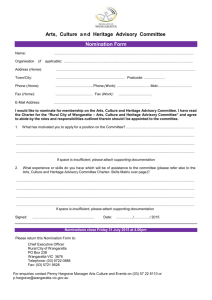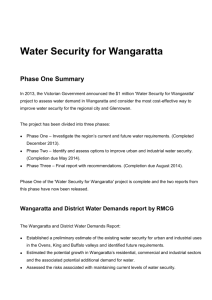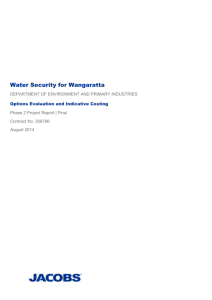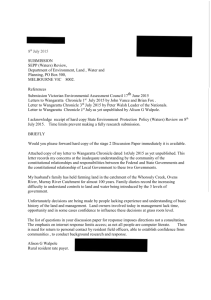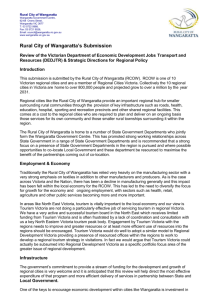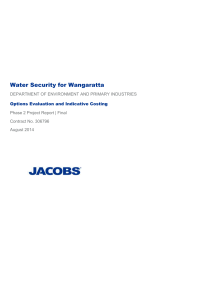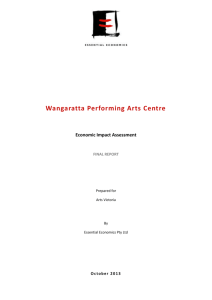Options - Department of Environment, Land, Water and Planning
advertisement
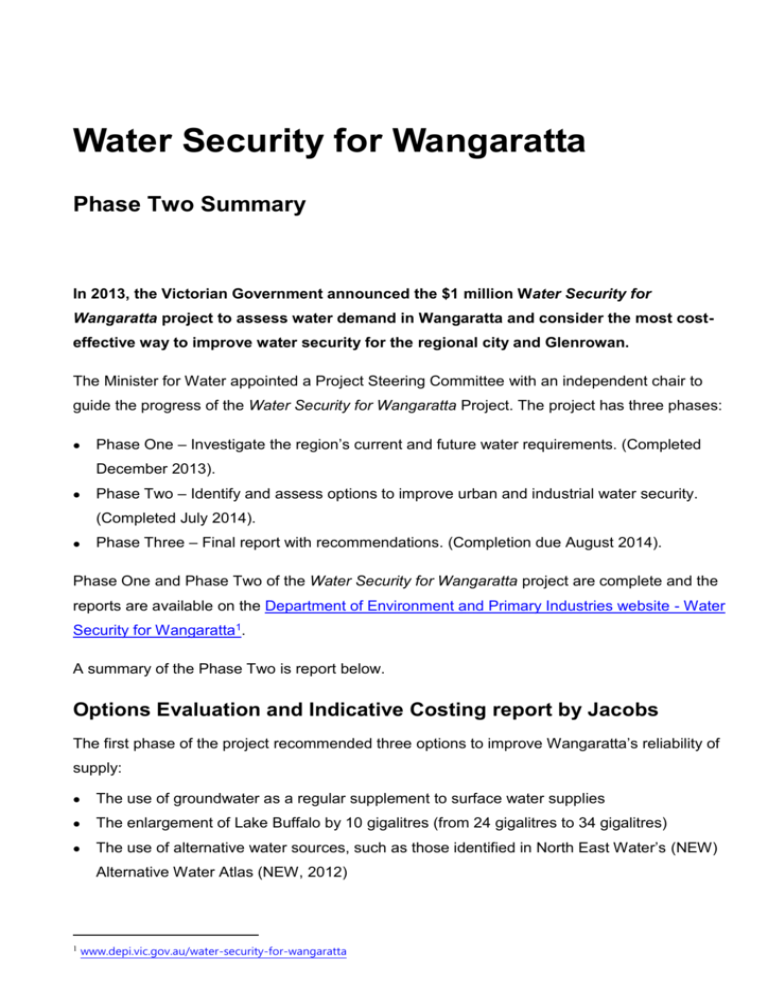
Water Security for Wangaratta Phase Two Summary In 2013, the Victorian Government announced the $1 million Water Security for Wangaratta project to assess water demand in Wangaratta and consider the most costeffective way to improve water security for the regional city and Glenrowan. The Minister for Water appointed a Project Steering Committee with an independent chair to guide the progress of the Water Security for Wangaratta Project. The project has three phases: Phase One – Investigate the region’s current and future water requirements. (Completed December 2013). Phase Two – Identify and assess options to improve urban and industrial water security. (Completed July 2014). Phase Three – Final report with recommendations. (Completion due August 2014). Phase One and Phase Two of the Water Security for Wangaratta project are complete and the reports are available on the Department of Environment and Primary Industries website - Water Security for Wangaratta1. A summary of the Phase Two is report below. Options Evaluation and Indicative Costing report by Jacobs The first phase of the project recommended three options to improve Wangaratta’s reliability of supply: The use of groundwater as a regular supplement to surface water supplies The enlargement of Lake Buffalo by 10 gigalitres (from 24 gigalitres to 34 gigalitres) The use of alternative water sources, such as those identified in North East Water’s (NEW) Alternative Water Atlas (NEW, 2012) 1 www.depi.vic.gov.au/water-security-for-wangaratta Objective The objective of Phase Two was to undertake a more detailed analysis of the three options listed, and recommend which of them would provide the most benefit, with the least negative impact and the best value for money. To do this, concept designs were completed for the three options and their costs, benefits and impacts were compared using a triple bottom line (TBL) assessment. The options were designed with the aim of providing 90% reliability of supply to Wangaratta under a “return to dry climate” and future (2060) demand scenarios. The “return to dry climate” represents a repeat of climate conditions that were experienced from 1997/1998 to 2008/2009. The results of this analysis are detailed in the table below. Indicative costs Option Estimated Estimated Net present capital cost additional value operating cost Additional ground-water use $15 million $260,000*1 $17 million Enlarge Lake Buffalo $80 million $0*2 $54 million*3 Alternative water use $95 million $1 million $86 million*4 Notes 1 for “return to dry climate” scenario 2 relative to current operating costs 3 accounts for avoided future dam safety upgrades 4 accounts for avoided costs in developing additional agricultural re-use schemes Options Groundwater use Existing North East Water (NEW) currently operates three groundwater bores on two sites - two bores at Kerr St and one bore at Faithfull St near the Wangaratta Water Treatment Plant. The bores operate with two main constraints: The water must be treated to meet Australian Drinking Water Guidelines and Daily and annual pumping limits (Goulburn-Murray Water licence conditions). Concept designs The concept design to increase groundwater supply factored in the following: Groundwater bores would be used whenever surface water extraction was restricted, therefore the bores would need to operate daily for long periods of time (up to 40 weeks per year during extreme droughts). Pumping could take place for 16 hours and recover for 8 hours to remain within available drawdown limits. The concept design showed that with two additional bores, NEW could deliver 90% reliability of supply under historic “return to dry” and 2060 median climate conditions. The design included an upgrade to the water treatment infrastructure at Kerr St and a new groundwater bore and water treatment infrastructure at Phillipson St. The report considered multiple options for the second new groundwater bore but further investigation is needed to determine the final site for the second bore. Lake Buffalo Existing Lake Buffalo was built in 1965 and holds 24 gigalitres at full supply level. Safety upgrade works were undertaken at the dam in 2003. Concept design The concept design for enlarging Lake Buffalo was based on recommendations and concepts from the URS (2003) report from the 2003 safety upgrade works. In order to enlarge the dam’s capacity by 10 gigalitres, significant infrastructure works and embankment changes would be required. These include raising the main and secondary embankments by 3.8 metres, raising the primary spillway crest by 6.5 metres, widening the secondary spillway from 100 metres to 150 metres, installing a fuse plug embankment, creating a 160 metres wide tertiary spillway through an overflow portion in the secondary embankment and raising the two-lane road and bridge along the embankments. The expansion would result in the inundation of the current recreational facilities so these would need to be relocated. The expansion would also require the buyback of a volume of High Reliability Water Shares to comply with the Murray-Darling Basin Agreement’s Sustainable Diversion Limits for the Ovens catchment. The concept design raises the full supply level (FSL) of Lake Buffalo by 2.9 metres, thus increasing its storage capacity from 24 gigalitres to 34 gigalitres. For more detail, please read the full report at the Department of Environment and Primary Industries website - Water Security for Wangaratta2. Alternative water use Options considered The study considered the following options: 1. Store treated trade waste via managed aquifer recharge (MAR) – this is unlikely to be approved by the Environment Protection Authority (EPA). 2. Store treated trade waste in a new storage at Sandford Rd, Wangaratta – would provide only 200 megalitres to 400 megalitres per year. 3. Capture storm water at Sandford Rd, store with MAR – requires MAR and additional groundwater infrastructure. 4. Capture storm water in new storage at Sandford Rd – provides less water than the recycled water option. 5. Use water recycled from the Wangaratta Wastewater Treatment Plant – this was considered the most feasible option because recycled water is a reliable, climate independent source of water. Alternative water use options will only increase Wangaratta’s reliability of supply if these options reduce the demand for potable water. The reduction in potable water demand required to achieve 90% reliability in the “return to dry climate” and future (2060) demand scenarios was estimated as 944 megalitres per year. Concept design The study found that only the recycled water option could provide the necessary reduction in potable water usage to increase the reliability of Wangaratta’s water supply. The supply of recycled water to potential industrial, commercial customers and the Rural City of Wangaratta could reduce their demand for potable water by 700 megalitres (90%). This change would be sufficient to increase the reliability of supply to 90% in the historic and median climate change scenarios but not in the “return to dry climate” change scenario. 2 www.depi.vic.gov.au/water-security-for-wangaratta To achieve 90% reliability of supply under all scenarios, a further 250 megalitres per year of residential demand would need to be met using recycled water, estimated as being equivalent to providing recycled water to about 3,100 Wangaratta households for outdoor use. The concept design for this option comprised: Upgrade of Wangaratta Wastewater Treatment Plant to produce approximately 8 megalitres/day of Class A recycled water. A new recycled water storage tank and pump stations A pipe reticulation network to supply industrial, commercial, council and residential customers. Indicative costings Indicative costings for all three concepts included: Capital costs based on estimated: Direct construction costs, Indirect costs as a percentage of direct costs, 50% contingency based on direct and indirect costs, Offsets required (i.e. vegetation; water entitlement buyback), and Operating costs based on estimated: Treatment and pumping costs and Maintenance costs. Triple Bottom Line assessment Triple Bottom Line (TBL) assessment criteria were developed through consultation with the Project Steering Committee and included the following categories: Financial Net cost Third party impacts Environmental impacts Flora and fauna Surface water Social Reliability for downstream users Cultural heritage Amenity and recreation Community acceptance Pricing impact Technical Resilience Timing and complexity of implementation These were weighted in accordance with the Department of Treasury and Finance’s recommendations. Findings Additional groundwater use is the highest ranked option and is not sensitive to the criteria weighting. Enlarging Lake Buffalo scored lower on environmental and technical criteria due to complexity of the works as well as the price impact on irrigators. The alternative water use option scored lower because of high capital and operating costs. Additional groundwater use scores highest on technical criteria because it: Can be implemented in stages to minimise cost pressure on customers. Is a climate independent source of water which is unaffected by surface water events e.g. bushfires. Requires less time for implementation and is less complex. Additional groundwater also has fewer environmental and social (primarily pricing) impacts. You can read the Executive Summary or the full Options Evaluation and Indicative Costing report at the Department of Environment and Primary Industries website - Water Security for Wangaratta3. What happens next? The Project Steering Committee will consider this report and its findings before making a recommendation to the Minister for Water in August 2014. 3 www.depi.vic.gov.au/water-security-for-wangaratta How do I get involved? Further information is available at the Department of Environment and Primary Industries website - Water Security for Wangaratta4. To contact the Project Steering Committee, please email watersecurity.wangaratta@depi.vic.gov.au. 4 www.depi.vic.gov.au/water-security-for-wangaratta
